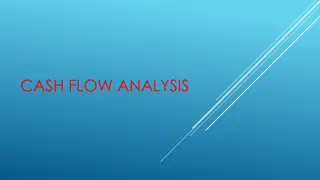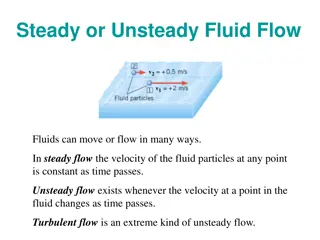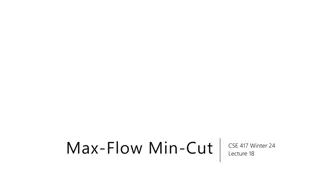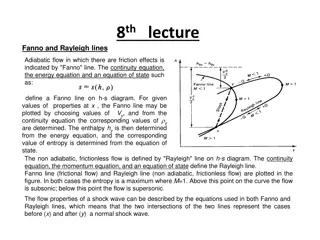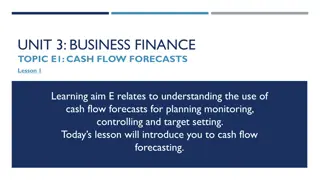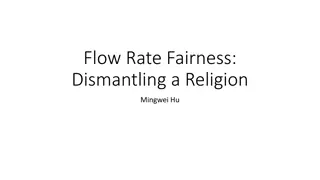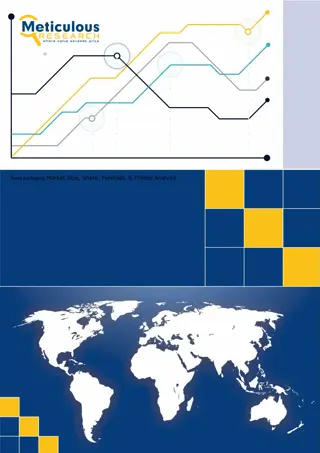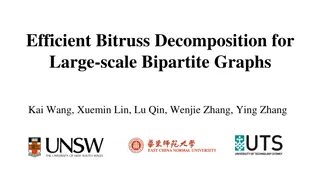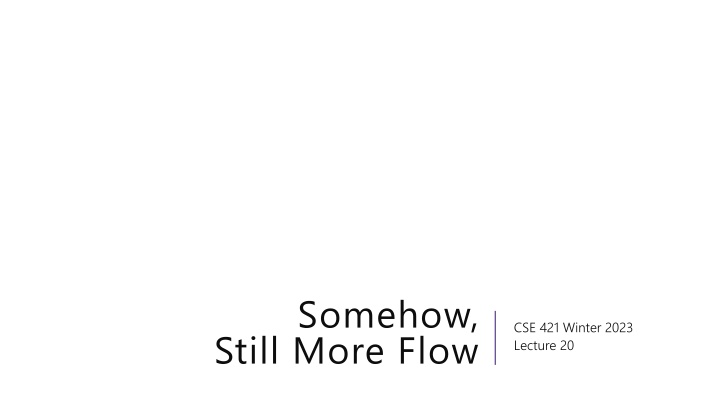
Network Flow Theory for Baseball Division Winners
Explore how network flow theory is used to determine potential division winners in baseball based on remaining games and team performance. Learn how max flow and min-cut concepts play a crucial role in identifying which teams are eliminated from contention.
Download Presentation

Please find below an Image/Link to download the presentation.
The content on the website is provided AS IS for your information and personal use only. It may not be sold, licensed, or shared on other websites without obtaining consent from the author. If you encounter any issues during the download, it is possible that the publisher has removed the file from their server.
You are allowed to download the files provided on this website for personal or commercial use, subject to the condition that they are used lawfully. All files are the property of their respective owners.
The content on the website is provided AS IS for your information and personal use only. It may not be sold, licensed, or shared on other websites without obtaining consent from the author.
E N D
Presentation Transcript
Somehow, Still More Flow CSE 421 Winter 2023 Lecture 20
Angels Rangers Mariners A s Making a Network Angels - 5 3 4 Rangers 5 - 4 3 Mariners 3 4 - 5 A s 4 3 5 - Team Wins (?) Possible Wins (?) Angels vs. Rangers Angels Angels 81 93 1 5 Rangers 80 92 Mariners 70 82 4 2 Angels vs. A s A s 69 81 Rangers We re done! 13 3 Rangers vs. A s A s
Interpreting the answer If the max flow has value equal to number of games, we know how the Mariners can still win the division. If the max flow is less than that, the Mariners can t win the division! (if they could win the division, then there is a way that the remaining games could play out with the mariners having as many wins as anyone else, but then we could make a feasible flow by assigning a unit of flow for each winner).
Angels Rangers Mariners A s Max Flow Angels - 5 3 4 Rangers 5 - 4 3 Mariners 3 4 - 5 A s 4 3 5 - Team Wins (?) Possible Wins (?) 1/ Angels vs. Rangers Angels Angels 81 93 2/ 1/ 1 3/ 5 Rangers 80 92 Mariners 70 82 4/ 4 2 2/ Angels vs. A s A s 69 81 Rangers This is the maximum flow. What s the min-cut? 7/ 13 4/ 3/ 3 {s, Angels vs. Rangers, Angels, Rangers} is one side of the cut. Rangers vs. A s 3/ A s The Angels and Rangers were enough to prove that the Mariners couldn t win!
Generating Proof that youre eliminated How do you describe to the general public that the Mariners are eliminated. People are going to say the Mariners can still win 82 games, no one has one 82, it s not over yet! Of the Angels and Rangers, they will win (combined) at least 81 + 80 + 5 games (Angels wins, Rangers wins, games to be played among these teams) On average On average they win 166 beating that average, and whoever that is the Mariners won t catch them. 2= 83games. That s more than 82. Someone is
In General Find the max flow. If its value is the number of games remaining, great! Mariners can still win. If its value is less than that, find the min cut. The set of all teams reachable from ? in the residual graph will show you why are eliminated. why the Mariners
Takeaways If you want to assign things, max-flow might be a good option. If you say at most you can probably just make a capacity constraint Onceyou can do an exactly equal or at least by checking the value of the max-flow. Sometimes you want an extra layer or two if you have a multiple types of assignments. Sometimes you can convert an at least in one group into an at most on another group.
Optional: Why is there always an explanation?
??? is games to be played between ? and ? ? is number of wins possible for Mariners ?? is current number of wins for team ?. An Explanation Always Exists Let (?, ?) be a min-cut. There s a lot of structure in the min-cut. Let ? be the set of teams whose vertices are reachable from ? after the edges have been cut. Angels vs. Rangers The capacity of the cut is ? ? or? ????+ ? ?? ?? Angels 1 5 And the capacity of the cut is less than ?,???? (because that is a cut, and we can t have a flow of that value). 4 2 Angels vs. A s Rangers ? ???+ ?,? ???,? |?| If ? is a set of teams, let ? ? = the average 13 3 number of games won be a team in ?. Rangers vs. A s A s
??? is games to be played between ? and ? ? is number of wins possible for Mariners ?? is current number of wins for team ?. An Explanation Always Exists ? ? or? ????+ ? ?? ?? < ?,???? ? ?? ?? < ? ?,? ???? ? ? < ? ?,? ????+ ? ??? After subtracting pairs where at least one of ?,? are not in ? all that remains are pairs where both ?,? are in ?. Move ?? to the other side. ? is a constant, so we just add |?| copies of ?. ? ?,? ????+ ? ??? ? ? < That is, the average number of wins for a team in ? (after all games are played) is strictly more than the possible number of wins for the Mariners.
Summary To tell whether your favorite team is eliminated, you can run a max-flow computation on a graph with ?(?2) vertices and ?(?2) edges. If your team is eliminated, there is a witness set of teams that must average more wins than is possible for your team.
Today One last day of max-flow. Two new problems we can solve with max-flow/min-cut. Today s proofs are short but subtle; I m intentionally taking us through slowly. Please ask questions.
A (possibly) simple problem Given a bipartite graph, find a maximum matching. A matching matching is a set of edges that do not share an endpoint. Think of it as matching the endpoints of the edges to each other. A stable matching is a particular matching on a complete bipartite graph.
A (possibly) simple problem Given a bipartite graph, find a maximum matching. A matching matching is a set of edges that do not share an endpoint. For example, on this graph the red edges are a maximum matching. There is no way to get 4 edges in a matching.
A (possibly) simple problem Design an algorithm to find a maximum matching on a bipartite graph. (hint: what if the vertices on one side are chores and the other are housemates).
Algorithm for Bipartite Maximum Matching Use the tuple selection/assignment we did last week!
Algorithm for Bipartite Maximum Matching Add a dummy source and sink. Attach each to one side.
Algorithm for Bipartite Maximum Matching Add a dummy source and sink. Attach each to one side. Direct (previously undirected) edges toward sink
Algorithm for Bipartite Maximum Matching Add a dummy source and sink. Attach each to one side. Direct (previously undirected) edges toward sink. Capacity 1 entering and leaving each (real) vertex ensures matching ?/1 ?/1
Algorithm for Bipartite Maximum Matching Add a dummy source and sink. Attach each to one side. Direct (previously undirected) edges toward sink. Capacity 1 entering and leaving each (real) vertex ensures matching Capacity in the middle (it ll help later) ?/ ?/1 ?/1
Algorithm for Bipartite Maximum Matching Add a dummy source and sink. Attach each to one side. Direct (previously undirected) edges toward sink. Capacity 1 entering and leaving each (real) vertex ensures matching Capacity in the middle (it ll help later) ?/ ?/1 ?/1
Algorithm for Bipartite Maximum Matching Add a dummy source and sink. Attach each to one side. Direct (previously undirected) edges toward sink. Capacity 1 entering and leaving each (real) vertex ensures matching Capacity in the middle (it ll help later) Red edges have flow. Take edges with flow for the matching. ?/ ?/1 ?/1
Algorithm for Bipartite Matching Modify the (undirected) graph ? into the network flow graph. Find a maximum flow, taking all edges of ? which have flow. Is it correct? The set of edges found should be a matching. There should be no larger matching.
Algorithm for Bipartite Matching Modify the (undirected) graph ? into the network flow graph. Find a maximum flow, taking all edges of ? which have flow. Is it correct? The set of edges found should be a matching. Capacities ensure no edge has more than one unit of flow through it. By integrality of flow, we have only one edge. There should be no larger matching. Suppose, for contradiction, that ? is a larger matching, then put a unit of flow on ?, entering each vertex with an endpoint in ? on the left and leaving on the right. This is a valid flow! But then its value is |?|, which would be larger than the max-flow, a contradiction.
Solving a new problem (with matchings) Let ? be an undirected graph. A minimum vertex cover is the smallest set of vertices such that every edge has at least one of its endpoints in the set. Here s an algorithm to find a minimum vertex cover in a bipartite graph
Vertex Cover How to find a vertex cover? Well a max-flow says you can t use this edge; (at least) one of its endpoints is already used by the matching. Here s a vertex cover (in gold). Notice something about it? ?/ ?/1 ?/1
Vertex Cover Here s a vertex cover (in gold). Find the min-cut (write residual graph) ?/ ?/1 ?/1
Vertex Cover Flow graph ?/1 ?/ ?/1 Residual; Cut in blue X s
Vertex Cover How to find a vertex cover? Well a max-flow says you can t use this unsaturated edge; (at least) one of its endpoints is already used by the matching. Here s a vertex cover (in gold). Notice something about it? It looks a lot like the min cut. ?/ ?/1 ?/1
Vertex Cover Let ? be the left bipartition, ? the right side. Let (?,?) be the min-cut. ??= ? ?;??,??,?? defined correspondingly. Here, ?? and ?? form a vertex cover ?/ ?/1 ?/1
Vertex Cover Is ?? ?? always There are 4 potential kinds of edges. Which kind is a problem for the vertex cover? Can they all exist? ?? to ?? ?? to ?? ?? to ?? ?? to ?? ?/1 always a vertex cover? If so, how big is it? ?/ ?/1
Vertex Cover Is ?? ?? always There are 4 potential kinds of edges. Which kind is a problem for the vertex cover? Can they all exist? ?? to ?? ?? to ?? ?? to ?? ?? to ?? ?/1 always a vertex cover? If so, how big is it? Only kind we have to worry about!! But you can t have an edge from ? to ?! We have a vertex cover. ?/ ?/1
Vertex Cover How big is ?? ??? Well, it looks a lot like the min-cut. ?,?? and (??,?) are cut. Each of those edges is capacity 1. Each has an endpoint we put in the vertex cover! ?? ?? = cap ?,? = |?|. ?/ ?/1 ?/1
But is it a minimum VC? So it s a vertex cover, of size equal to the min-cut what if there s a smaller vertex cover? Let ? be any vertex cover, define ??,BX as before.
No smaller VC Let ? be any vertex cover, define ??,BX as before. Claim: ( ? ?? (? ??), ? ? ?? ??) is a cut with cut edges are ?,??,(??,?). [this is the corresponding cut to before] ?/ ?/1 ?/1
But is it a minimum VC? So it s a vertex cover, of size equal to the min-cut what if there s a smaller vertex cover? Let ? be any vertex cover, define ??,BX as before. Claim: ( ? ?? (? ??), ? ? ?? ??) is a cut with cut edges are ?,??,(??,?). No (? ??), (? ??)edges because we re a cover!
No smaller VC Every vertex cover lets you discover a cut of the same size. Our algorithm found a VC of size equal to the minimum cut! A smaller VC would give a smaller cut! But there isn t one. So we have found the min VC. ?/ ?/1 ?/1
Wrapping it up You can find the following of a bipartite graph (using only flow) 1. Maximum matching 2. Minimum Vertex cover And their value is equal to the size of the max-flow (and the min-cut) in the modified graph. K nig sTheorem (aka K nig-Egevary Theorem) In a bipartite graph, the size of the maximum matching is equal to the size of the minimum vertex cover.
Wrapping It Up We ve found maximum matchings and minimum vertex covers in bipartite graphs using flow. If your graph isn t bipartite: Efficiently finding a maximum matching is still possible. but more complicated. Look up Edmond s Blossom Algorithm Efficiently finding a minimum vertex cover, is a taller task. It s an NP-complete problem. We ll more clearly define what that means next week.
But Wait, Theres More Applications! Finding Edge disjoint paths in a directed graph. Maximum number of paths from ? to ?that don t repeat an edge. I want to send a packet from ? to ? but edges are unreliable. Want completely independent copies. Finding internally-vertex-disjoint paths in a directed graph Send packet, but I don t trust the vertices. Image Segmentation A surprisingly useful tool for matching and separating things. Also for proving graph theory results (Konig-Egevary, Hall s Theorem)






